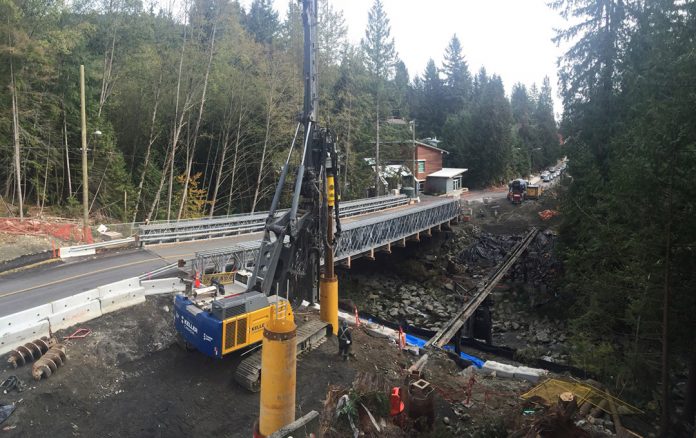When the time came to replace the Montroyal Bridge over Mosquito Creek in North Vancouver, Acrow Bridge was recruited to furnish a modular steel panel bridge to provide temporary access.
The old structure was a 60-year-old timber bridge which was both under-capacity and at the end of its useful life.
As the existing bridge was nearby a fire station, it was critical that the detour structure be in place before demolition began in order to provide access for emergency vehicles. In addition, the route is heavily travelled by commuters.
The rented two-lane TL24 structure from Acrow is 39.6 metres long by 7.3 metres wide curb to curb, with guard rails and a sidewalk.
The owner of the project is the Corporation of the District of North Vancouver, B.C. The contractor is Eurovia BC Inc. who selected the Acrow bridge for the job. The design engineer for the detour for Eurovia was All-Span Engineering & Construction Ltd. and McElhanney Consulting Services Ltd. The design engineer for the owners was WSP Canada Inc.
“The Acrow structure was chosen over other temporary bridge options due to its light weight modular components allowing for staged installation that otherwise would have presented many challenges with a beam structure,” said Lyle Johnson, manager of field operations for Eurovia BC. “The bearing to finished deck clearance at each end of the bridge minimized the excavation required for foundation installation.”
The launching and erection of the bridge posed numerous challenges. As there was no room available to stage components on-site, the Acrow components were delivered to a lay-down area 4 km from the site and brought to the work zone as needed.
RELATED: A customized access system helps build Muskrat Falls turbines
The build area for the Acrow detour bridge was limited to 12.2 metres by 9.75 metres on the west approach. The bridge was erected on rollers, with additional rollers on top of a temporary launching pier necessary for ease of erection and a safe launch.
For the final launch, a large crane, positioned on the east approach, was attached to the east end of the bridge. The bridge was moved to final position and held 2 metres above the east bearings while the temporary pier was removed. The bridge was then lowered and set on both abutment bearings.
It is anticipated the temporary bridge will be in place throughout construction, which is scheduled for completion this summer.













